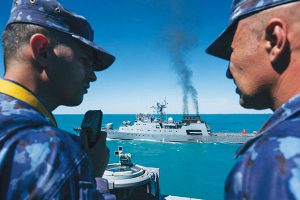Bloomberg
It didn’t take long after Russia attacked Ukraine for French Colonel Clement Torrent to get his orders: He had six months to build a base for 1,000 soldiers on Nato’s eastern frontier.
He and about 200 troops from France, Belgium and the Netherlands are now busy leveling a hilltop in the Romanian region of Transylvania. “Our due date is before the first frost,†Torrent, who leads the engineer task force, said from the base near Cincu, about 260 kilometers (162 miles) north of Bucharest by road. “It’s a sign of solidarity. An alliance needs to be tangible.â€
As Western powers race to confront the threat posed by Vladimir Putin, Russia’s war on its neighbor has answered a fundamental question that North Atlantic Treaty Organization states have been asking for years: whether older members like the US, France and Germany will fight for less wealthy ex-communist allies if they’re attacked.
But it has raised others, including whether the alliance is doing enough to deter Russian expansionism after years of underinvestment and ignored warnings, and whether the effort to reinforce the previously neglected Black Sea region should have happened long ago.
Six months after Putin’s invasion of Ukraine, Nato’s focus is firmly on how to thwart Russia in Europe’s southeast corner and prevent one of the continent’s poorest regions from becoming its soft underbelly of security.
The Black Sea divides Europe from Asia and is surrounded by Russia, Ukraine, Romania, Bulgaria, Turkey and Georgia. It’s a critical trade route for agricultural products from Ukraine and Russia and links with the Mediterranean Sea via Turkey’s Bosphorus Strait.
Moscow has prioritized southeastern Europe, according to Matthew Orr, a security analyst at Stratfor. Its buildup there “shows how much the Russians are concerned about this region, how much they want to have a strong military footprint there — to which Nato has to respond,†he said.
For years, Eastern European leaders had warned that the threat from Russia was building after Moscow attacked Georgia in 2008. Then in 2014, Putin instigated a war in Ukraine’s eastern Donbas region and seized Crimea.
During that time, the Kremlin bolstered its military capabilities in the Black Sea, shifting land forces, strengthening air defenses and modernizing its sea fleet as it stepped up activity in war zones including Libya and Syria, where it has a naval base. “The Black Sea itself is Russia’s gate to warm water, particularly to the Mediterranean,†said Iulia Joja, the director of the Black Sea program for the Washington-based Middle East Institute think tank. “It’s Russia’s gateway to projecting power and force into the Middle East, into Africa and beyond.â€
Just weeks after the Feb. 24 invasion, the alliance agreed at a summit in Brussels to create four new battle groups for Romania, Bulgaria, Hungary and Slovakia, to complement four it had deployed to Poland and the Baltic states as part of a so-called “tripwire†approach.
Romania, a country of almost 19 million that shares a border of almost 640 kilometers with Ukraine, was already hosting about 1,000 mostly US NATO soldiers before the war, with the Black Sea base at Mihail Kogalniceanu serving as a transit point for conflict zones in the Middle East.
Following Russia’s attack on Ukraine, Nato allies significantly bulked up their presence at the alliance’s eastern borders, deploying more troops, jets and ships. The plan now is to create garrisons in the remaining borderline Nato states where new units of international forces comprising about 1,000 troops will be regularly rotated. In addition, allies will identify units at home that can swiftly join up with troops already on the ground in the eastern states if needs be.
 The Gulf Time Newspaper One of the finest business newspapers in the UAE brought to you by our professional writers and editors.
The Gulf Time Newspaper One of the finest business newspapers in the UAE brought to you by our professional writers and editors.
